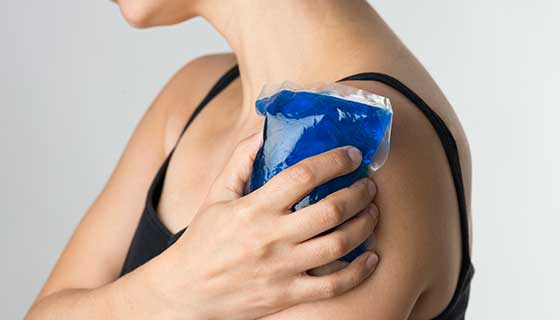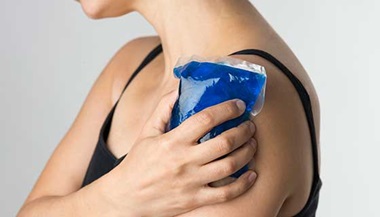Shoulder Bursitis
- Bursa are sac-like structures located where there may be friction in the body — like between tendons and bones. When there is too much friction, the bursa become irritated and inflamed leading to bursitis.
- There are generally three types of bursitis: 1) chronic bursitis, 2) infected bursitis, and 3) traumatic bursitis.
- The symptoms of bursitis vary by type and severity, but may include swelling, excessive warmth at the site, tenderness, pain and/or fever.
- Depending on the type of shoulder bursitis, treatment may include activity modification, immobilization with a splint, icing, injections, aspiration of the bursa (removing fluid with a syringe), antibiotics or anti-inflammatory pain medication.
- Surgery is rarely needed to treat bursitis.
What is bursitis?
Bursitis is an inflammation of a bursa. It is a condition usually characterized by pain and sometimes by redness and swelling. A bursa is a very thin (i.e., a few cells thick), sac-like structure that is located wherever there might be friction, such as between skin and bones, between tendons and bones or between ligaments and bones. In other words, they serve to decrease the friction that occurs between hard bone and softer tissues. A good analogy is rubbing leather over the corner of a table — over time, you would rub a hole in the leather. Skin, tendons, and ligaments would likewise wear out if there were no bursa between them and bony surfaces. As a result, there are over 150 bursae in the body, wherever there is the possibility of rubbing.
A bursa is normally very thin and does its job without notice. However, if there is too much friction, it reacts by getting inflamed or irritated. When this happens the bursa gets thicker and sometimes produces fluid to create more cushion. It goes from being very thin (like tissue paper) to thick and lumpy (like corrugated cardboard). The bursa can be very large if a lot of fluid is produced inside. Sometimes it can be colonized by bacteria, and in this case, becomes an infected bursa. It can be difficult to distinguish an inflamed bursa (irritated with no infection) and an infected bursa (irritated with infection or bacteria present).
While bursae are present all over the body, the most common areas where inflammation or irritation occurs are at the elbow, knee, and shoulder (see below). The terms “housemaid’s knee” (i.e., bursitis following domestic work done on the hands and knees), “miner’s elbow” (bursitis following work in mines performed on the hands and knees) or “student’s elbow” (bursitis following hours of studying with the elbows pressed against a table) are sometimes used to refer to bursitis in a specific group of patients due to repetitive friction.
What causes bursitis?
There are several ways to get bursitis, but the condition is usually caused by too much stress on the bursa. In general, however, bursal irritation can be roughly divided into three groups. The first type, known as chronic bursitis, may be due to a variety of factors. This type is the most common and develops over time due to repetitive irritation of the bursa. Most people who get this type have no predisposing problems, and the inflammation occurs for no apparent reason. It occasionally can occur in people who have a preexisting medical condition that causes the bursa to swell. While not the most usual cause of this type of bursal swelling, it can be seen in people who have gout, pseudogout, diabetes, rheumatoid arthritis, uremia, and other conditions.
The second type is called infected bursitis and is more serious. In this type, the bursa becomes infected with bacteria. If the infection spreads, it can cause serious problems.
The last type, typically seen in athletes, is called traumatic bursitis (or acute traumatic bursitis). Of the three types, it is the least common. It is due either to repetitive rubbing of an extremity against a hard surface or from too much bending of the joint.
What are the symptoms of bursitis?
The symptoms of bursitis depend on the severity of the inflammation and the type of bursitis present. In chronic bursitis, swelling is the most obvious symptom. Patients with this type often seek medical attention because they notice swelling that has gone on for some time and does not improve. It is rarely painful and usually not reddened. However, this type of bursal swelling can get warm and painful without being infected.
In infected bursitis patients usually experience excessive warmth at the site of the inflamed bursa. They often complain of a great deal of tenderness, pain, and fever. The swelling and redness may spread away from the affected site and go up or down the arm. Also, an infected bursa can make you feel very sick, feverish and tired. If you have any of these symptoms, it is very important to seek immediate medical attention.
Traumatic bursitis presents with the rapid onset of swelling. These cases usually occur after a specific event, such as when a lacrosse or football player hits his or her elbow on hard artificial turf, or when a wrestler hits his elbow on a mat. The affected area may be somewhat tender and warm but not to an excessive degree. The swelling may also be accompanied by bruising.
How can I tell which type of bursitis I have?
The symptoms sometimes point to one type of bursitis over another, but the distinction is often hard to make. This is especially the case when trying to differentiate chronic bursitis from an infected bursa. Chronic bursitis presents with swelling but lacks the other more serious signs of an infected bursa. They include redness, inflammation, fever, and pain. Medical attention should be sought when these symptoms appear.
What is the treatment for bursitis?
The treatment depends on the type of bursitis you have. Chronic bursitis is treated by a reduction in the activities that cause swelling. In some cases, it may even be necessary to immobilize the affected extremity with a splint. In addition, treatment of this type includes padding (i.e., knee or elbow pads) and the use of anti-inflammatory medications (i.e., ibuprofen, Naprosyn, Celebrex, etc.) for a few weeks. We recommend icing two or three times per day for 20 to 30 minutes each time until the swelling is gone. Swelling may not disappear for several weeks. Heat should not be used since it will increase the inflammation. Injection of steroids into the bursa may decrease the swelling and inflammation but can be associated with unwanted side effects (infection, skin atrophy, chronic pain). Injection of cortisone is best reserved for those bursae that do not get better with the treatment above. In addition, any bursa that might be infected should not be injected with cortisone.
Infected bursitis requires immediate evaluation by your doctor. The physician may want to aspirate the bursa (i.e., take fluid out with a syringe) to reduce its size and to collect fluid needed to diagnose an infection. Antibiotics are needed to kill bacteria. The true danger with this type of bursitis is the risk that bacteria can spread to the blood. As with the other types of bursal inflammation, ice, rest, and anti-inflammatory medications improve swelling and inflammation.
Traumatic bursitis is normally treated by aspirating the bursa (i.e., using a small needle to draw fluid/blood from the affected bursa). Icing and NSAIDs (anti-inflammatory medications) help to reduce swelling. It is also important to compress the bursa with an elastic bandage and use padding upon returning to the activity that initially caused the problem. The use of protection is particularly important in football players (playing on artificial turf), wrestlers and basketball players. Also, gardeners, roofers, and carpet layers should take special precautions to prevent irritation to the knee area.
What can I do if the symptoms of bursitis do not improve?
Symptoms should improve if treated as described above. If you do not see an improvement, you may want to talk to your doctor. It is especially important to seek medical care if you think you may have an infection. You should also seek attention if you notice swelling in more than one area or if the swelling increases despite the treatment above.
When is surgery indicated for bursitis?
Surgery is rarely needed to treat bursitis and is usually done only in the chronic cases that have not improved with traditional therapy. The most common surgical treatment, if needed, is an incision and drainage (called an I and D) and is used only in cases of infected bursa. The surgeon first numbs the skin with an anesthetic and then opens the bursa with a scalpel. Finally, he or she drains the fluid present in the inflamed bursa. Sometimes it is necessary to excise the entire bursa surgically. This is indicated only if the bursal swelling causes problems.
Can bursitis be a sports-related injury?
Bursitis is quite uncommon in sports. Most cases fall under the acute traumatic type. As mentioned above, activities in which an athlete repeatedly rubs an extremity on a hard surface predispose him or her to bursitis (i.e., football, wrestling, and basketball). It is important to use knee or elbow pads to prevent the bursa from swelling.
What about bursitis in the shoulder?
Bursitis can also occur in the shoulder and is part of a process doctors use different names to describe: impingement, bursitis, rotator cuff tendinitis or biceps tendinitis. In this case, the bursa is usually inflamed but not swollen. The treatment is similar to chronic bursitis: ice, NSAIDs and range-of-motion exercises. If these do not work, then further treatment may be necessary.





